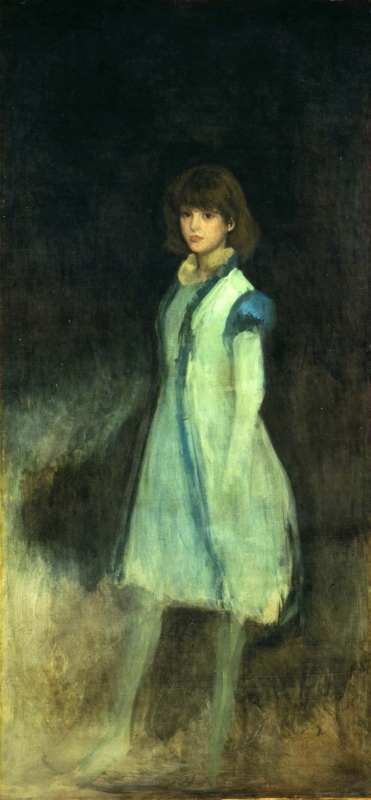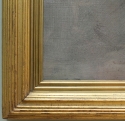Home > Catalogue > Browse > The Blue Girl: Portrait of Connie Gilchrist << >>
Composition
There are numerous revisions to the composition. Her right arm and hand have been almost scraped out. There is no sign of her left hand but a swirl of dark blue paint suggests Whistler originally intended that she should hold a hat. The background is very thinly painted – or scrubbed – but there are hints of a longer skirt, below her feet.
It is possible that it was reworked briefly by Whistler with another model. It is also possible that the portrait was painted over another figure.
The design of Connie's dress and its colour (the pale turquoise/blue dress with a blued-white over-dress, the little cream ruff, and puffed sleeves) look similar to Whistler's pastel study, r.: The Blue Girl; v.: Curtain [M.0521], for The Blue Girl: Portrait of Miss Elinor Leyland [YMSM 111]. The dress reappears in various guises, as Whistler returned to the subject for the next twenty years.
Later related works include Scherzo in Blue: The Blue Girl [YMSM 226], Harmony in Coral and Blue: Miss Finch [YMSM 237], and Harmony in Blue and Violet: Miss Finch [YMSM 239]. The last 'blue girl' was probably Blue and Coral: The Little Blue Bonnet [YMSM 500]. All of these include echoes and revisions of the 1870s dresses.
Technique
The canvas is of a fine plain weave. It was prepared with an off-white ground layer and there are traces in the upper left quadrant of a thin blue underlayer. 1
Thomas Robert Way (1861-1913) commented that Whistler began a 'Blue Girl' with Connie Gilchrist as model 'but had, perhaps, only one sitting.' 2 The freshness and spontaneity of the brushwork suggest that it was painted in very few sittings, but the signs of rubbing out and alterations are evidence of several sittings. The Hunterian website commented:
'Whistler must have prepared the full composition of blue tones on his palette before applying them – diluted and with great speed – onto the fine weave canvas. There is rubbing down in the light blue of Connie's dress and in the lower section of the painting.' 3
Given that the stretcher bears the stamp of Blanchet in Paris, it is possible that the canvas was either bought in Paris or – more likely – was at some time in Whistler's Paris studio.
Conservation History
The canvas was extended at the top and bottom by about 1 cm, and was poorly paste-lined, resulting in an uneven, pitted surface. The paint has faded slightly, except under the frame. The paint, already thin, is also abraded. There is some blanching on or beneath the varnish. However, the overall condition of the picture is stable. 4
Frame
Portrait Whistler frame, dating from ca 1878, 202.5 x 101.0 x 7.3 cm. It bears the stamp of Emile Blanchet (1852-1931) on the verso of the stretcher, 'BLANCHET / RUE SAINT BENOIT / PARIS'. 5
Last updated: 21st October 2020 by Margaret










